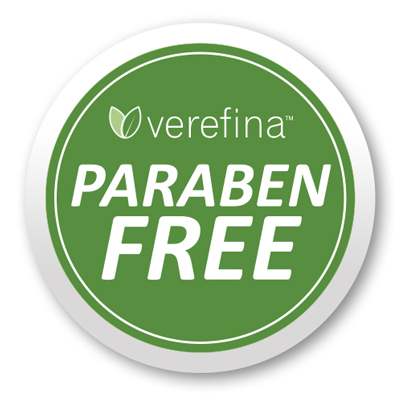The Effects of Parabens
Posted by Katie Zapotoczny on 9th Apr 2015

There are many ingredients that Verefina does not use in their products, and parabens are among them. Parabens are synthetic preservatives that are added to hundreds of personal care and cosmetic products, including shampoo, sunscreen, lotion, shaving gel, mascara, and foundation. They are also used in some foods and pharmaceuticals. Parabens prevent the growth of bacteria, yeast, and mold and keep products from spoiling. Manufacturers often use them to extend the shelf life of their products. While this may be a useful function, parabens have several downsides, too.
Xenoestrogens
So what are the problems with parabens? To begin with, much of what is put on the skin is absorbed into it and ends up in the bloodstream (source). So parabens don’t have to be ingested in order to get into the body; they can enter through the skin. Parabens are considered “xenoestrogens.” Xeno means “outside,” so they come from outside the body. Parabens are also sometimes described as hormone (or endocrine) disruptors because some of them mimic hormones- specifically estrogen (source). It has been recognized for at least a decade now that some forms of estrogen can play a role in the development of breast cancer (source).
While this is concerning, parabens appear to have a smaller estrogenic effect than estrogen produced naturally in the body (source). A 1998 study in Toxicology and Applied Pharmacology found that even the most potent paraben, butylparaben, has a much lower activity level than naturally occurring estrogen (source). While parabens’ estrogenic activity may be lower than the hormone itself, there are still reasons to be wary.
The Relationship Between Parabens and Breast Cancer
A 2004 study published in the Journal of Applied Toxicology found parabens intact in breast cancer cells. The study did not, however, find a direct cause and effect link between parabens and breast cancer; the fact that parabens were discovered in breast cancer cells doesn’t necessarily mean that they caused the cancer. The study was criticized because the researchers did not look at paraben levels in healthy tissue (source). But, since the parabens were found intact, this study seems to suggest that parabens are not easily broken down or eliminated from the body (source). Personally, I feel that this is alone is a good reason to avoid parabens as much as possible.
Other Problems Related to Parabens
There are other concerns related to parabens. In 2010, a group of scientists from the University of Michigan, Harvard School of Public Health, and the Centers for Disease Control and Prevention found a link between exposure to butylparaben and damage to DNA in sperm cells (source). Various types of parabens have also been associated with skin irritation, allergic reactions, and reproductive health problems (source).
Concluding Thoughts on Parabens
So where does this leave us? While parabens are used in small amounts in individual products, they are found in A LOT of them. So even though one particular product may not contain a high level, they can really add up if you are using more than one product with parabens. And since it would appear that parabens are not easily broken down or eliminated, they may be able to accumulate over time. I am therefore careful to avoid them as much as possible.
Do you want to limit your exposure to parabens, too? Just stick with Verefina! All of their products are free of parabens. Always have been, always will be.
Sources:
“Antiperspirants and Breast Cancer Risk.” American Cancer Society. 20 September 2013. Web. 31 March 2015.
Breyer, Melissa. “Parabens: Easy Greening.” Care 2. 20 January 2007. Web. 30 September 2013
http://www.care2.com/greenliving/parabens-easy-greening.html
Burnes, Deborah. “Putting it on Your Skin Does Let it in: What’s in Skin Care and How it Afffects Your Health.” Huffington Post. 21 June 2012. Web. 31 March 2015.
http://www.huffingtonpost.com/deborah-burnes/http/...
Conova, Susan. “Estrogen’s Role in Cancer.” Columbia University Health Sciences. 26 May 2003. Web. 6 April 2015.
http://www.cumc.columbia.edu/publications/in-vivo/...
Leiba, Nneka. “Common Cosmetics Ingredient Can Harm Sperm.” Environmental Working Group. 9 November 2010. Web. 31 March 2015.
http://www.ewg.org/enviroblog/2010/11/common-cosm...
“Parabens.” Food and Drug Administration. 31 October 2007. Web. 31 March 2015.
http://www.fda.gov/cosmetics/productsingredients/...
 About the Author
About the Author
Katie Zapotoczny is a Verefina Affiliate and the creator of An Ever Green Life, a blog that seeks to empower readers to make changes that will improve their health and help protect our environment.

